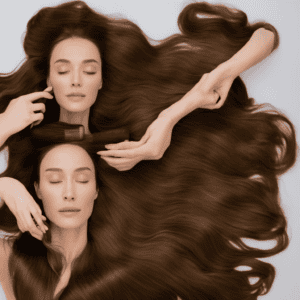When using hair repair oil, you’re likely making at least one of the common mistakes that can undermine the repair process. You might be overusing the oil, choosing the wrong type for your hair, or applying it to dirty hair. Perhaps you’re not prioritizing your hair ends or using the oil as a styling product. Whatever the mistake, it’s crucial to address it to reap the benefits of hair repair oil. By avoiding these common blunders, you’ll be one step closer to achieving the healthy, resilient hair you desire. Dive deeper to discover specific tips and tricks to get the most out of your hair repair oil.
Overusing Hair Repair Oil
When you slather on hair repair oil with reckless abandon, you might end up doing more harm than good. You’ve fallen victim to hair oil obsession, and excessive application is now your middle name. You think that the more oil, the merrier, but that’s not how it works. Overusing hair repair oil can weigh your hair down, making it look greasy and lifeless.
You might be thinking, ‘But I want to nourish my hair!‘ And that’s great, but there’s a fine line between nourishment and overkill. Excessive application can lead to buildup, clogging your hair follicles and causing more damage than good. Your hair starts to look dull, and the oil that was meant to repair it now makes it look like a hot mess.
Take a step back, and reassess your hair oil usage. Use it in moderation, focusing on the ends of your hair where it needs the most repair. Remember, a little goes a long way. Don’t let hair oil obsession get the best of you.
Choosing the Wrong Oil Type
One common mistake that can render your hair repair oil useless is selecting an oil type that’s incompatible with your hair type. You might think all hair repair oils are created equal, but that’s far from the truth. Different oils cater to different hair types, and using the wrong one can lead to more harm than good.
For instance, if you have oily hair, using a heavy oil like coconut oil can exacerbate the issue. On the other hand, if you have dry hair, a lightweight oil like argan oil mightn’t provide enough moisture. That’s why hair type consideration is crucial when choosing a hair repair oil.
Fortunately, you don’t have to limit yourself to a single oil type. Oil blending options are available, allowing you to mix and match different oils to create a customized blend that suits your hair type. By taking the time to choose the right oil or blend, you’ll be one step closer to achieving the hair repair results you desire.
Applying Oil to Dirty Hair
Since you’ve taken the time to select the right hair repair oil, make sure you’re applying it to a clean slate – dirty hair can hinder the oil’s effectiveness and even lead to more harm than good. When your hair is dirty, especially at the roots, the oil can’t penetrate properly, reducing its ability to repair and nourish your hair. Dirty roots create a barrier, preventing the oil from reaching the hair shaft, which can lead to ineffective absorption and reduced hair porosity. This can ultimately cause more damage, dryness, and breakage.
Before applying the oil, wash your hair with a gentle shampoo to remove dirt, oil, and product buildup. Towel-dry your hair until it’s damp, as this is the ideal state for oil absorption. By starting with a clean slate, you’ll ensure the oil can penetrate deeply, repairing and nourishing your hair from the inside out. This will help you get the most out of your hair repair oil and achieve the healthy, silky locks you desire.
Not Focusing on Ends First
Your hair’s most fragile and oldest parts, the ends, are also the most prone to damage, so it’s essential you prioritize them when applying hair repair oil. The ends of your hair are more susceptible to split ends, breakage, and dryness, which can travel up the hair shaft if left untreated. By focusing on the ends first, you’re targeting the most damaged areas and providing intense nourishment where it’s needed most.
When applying hair repair oil, start at the ends and work your way up. This ensures that the oil penetrates deeply into the hair cuticle, providing effective split end treatment. Regular hair trimming frequency is also crucial in preventing split ends from traveling up the hair shaft. By trimming your hair regularly, you’re removing damaged ends and preventing further damage.
Using Oil as a Styling Product
When you use hair repair oil as a styling product, you’re likely to weigh your hair down, rather than nourish it, which can lead to a greasy, limp look. This is because hair repair oils are typically formulated to provide intense nourishment, not to hold a style in place. Using it as a styling product can alter your hair texture, making it look dull and lifeless.
Moreover, using hair repair oil as a styling product can lead to product buildup. As you apply more and more oil to style your hair, it can accumulate on your hair shaft, causing a sticky, brittle texture. This buildup can be difficult to remove, requiring multiple washes to restore your hair’s natural texture.
To avoid this, use a light hold styling product specifically designed for your hair type, and reserve your hair repair oil for its intended purpose: nourishing and repairing your hair.
Ignoring Scalp Health Concerns
Failing to address underlying scalp health concerns, such as dandruff, itchiness, or irritation, can hinder the effectiveness of your hair repair oil and even exacerbate existing hair problems. You might be using the best hair repair oil out there, but if you’re not tackling the underlying issues, you’re only masking the symptoms. When you ignore scalp health concerns, you’re creating an environment where hair growth is stifled and damage is accelerated.
Regular scalp massages can help alleviate these issues by increasing blood flow and reducing tension. This, in turn, can help reduce flaky scalp causes like dandruff and itchiness. By addressing these concerns, you’re creating a healthy environment for your hair to thrive. It’s essential to identify and treat the root causes of your scalp issues before using hair repair oil. By doing so, you’ll be able to reap the full benefits of the oil and enjoy healthier, more vibrant locks. Remember, a healthy scalp is the foundation of healthy hair, so don’t neglect it!
Not Leaving Oil on Long Enough
By rushing to wash out your hair repair oil, you’re depriving your locks of the intense nourishment they need to recover from damage. Hair oil absorption is a process that requires patience, and shortening the treatment timing can undermine the entire repair process. When you apply hair repair oil, it takes time for the active ingredients to penetrate deep into your hair shaft, providing the necessary nourishment to repair and restore your hair.
If you’re washing out the oil too quickly, you’re not giving your hair the opportunity to fully absorb the nutrients. This can lead to subpar results, and your hair may still look and feel damaged. To get the most out of your hair repair oil, it’s essential to leave it on for the recommended time, usually 30 minutes to an hour.
This allows for optimal hair oil absorption, ensuring that your hair receives the intense nourishment it needs to recover from damage. By doing so, you’ll be on your way to healthier, stronger, and more resilient hair.
Conclusion
You’ve learned the common mistakes to avoid when using hair repair oil. Now, it’s time to get it right!
Remember, a little oil goes a long way, and choosing the right type for your hair is crucial. Apply it to clean hair, focusing on the ends first, and leave it on for a while.
Don’t use it as a styling product, and don’t ignore scalp health concerns. By avoiding these mistakes, you’ll be on your way to healthier, happier locks.






